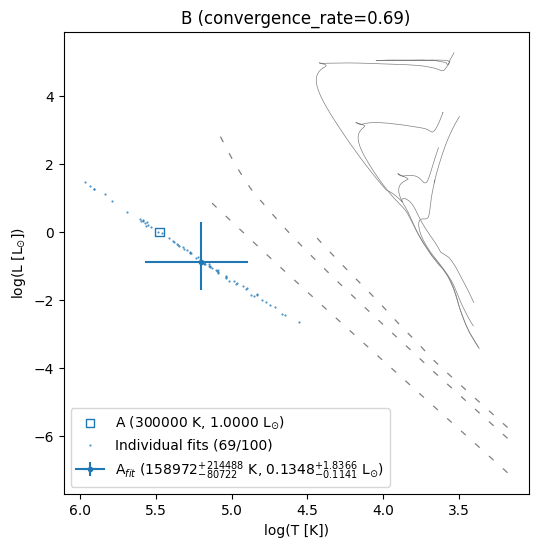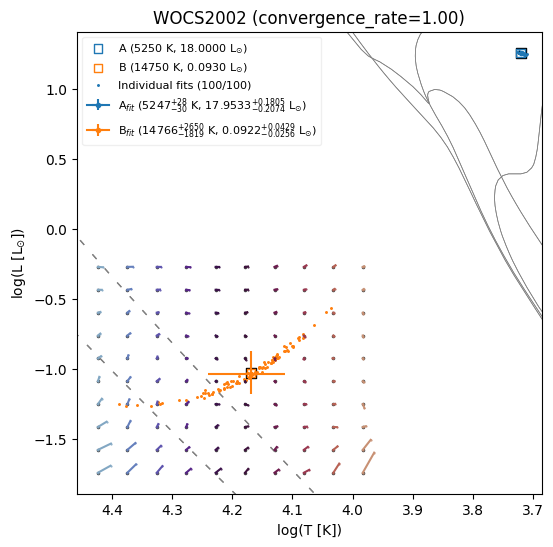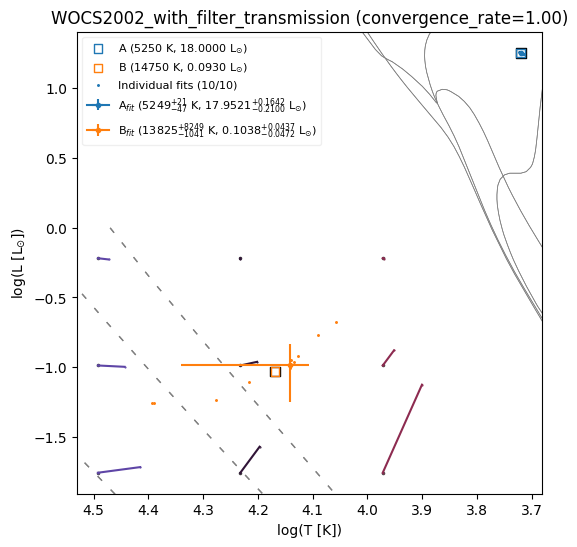Guide to estimate SED errors¶
from astropy import units as u
import numpy as np
import sed_analysis_tools as st
import warnings
warnings.filterwarnings("ignore")
Recommended approch¶
Create a
Binaryobject with the filter wavelengths, fractional errors and SED based stellar parameters (T_A_, L_A, T_B_, L_B)Use the
estimate_errorsto get lower limits to the fitting errors based on blackbody assumptionsUse
evaluate_pseudo_secondariesto understand if there is any degeneracy in the secondary recovery space
filter_set = st.FilterSet(list_pivot_wavelengths=np.logspace(3.2, 4.7, 16) * u.Angstrom)
starB = st.Star(T=300000*u.K,
L=1*u.solLum,
frac_err=0.3,
seed=0,
D=10*u.pc,
threshold_ewr=5.0,
filter_set=filter_set,
name='B')
starB.estimate_errors(niter=100,
verbose=True)
starB.plot_estimated_errors()
print(starB.df_error_summary)
B
-----
T_in = [300000.000000]
L_in = [1.000000]
T_fit = [158972.897116 +214488.545372-80722.128686]
L_fit = [0.134766 +1.836627-0.114097]
Convergence rate:0.69
logT 5.477121
logL 0.000000
T 300000.000000
L 1.000000
logT_Single_16 4.893402
logT_Single_50 5.201323
logT_Single_84 5.572227
e_logT_Single_upper 0.370904
e_logT_Single_lower 0.307922
logL_Single_16 -1.687507
logL_Single_50 -0.870419
logL_Single_84 0.294700
e_logL_Single_upper 1.165119
e_logL_Single_lower 0.817089
T_Single_16 78250.768429
T_Single_50 158972.897116
T_Single_84 373461.442487
e_T_Single_upper 214488.545372
e_T_Single_lower 80722.128686
L_Single_16 0.020669
L_Single_50 0.134766
L_Single_84 1.971393
e_L_Single_upper 1.836627
e_L_Single_lower 0.114097
dtype: float64

"""
Stellar parameters and flux error values are taken from the WOCS2002 star in M67. - Jadhav et al. (2019)
"""
frac_err = [
0.05341997,
0.05986721,
0.05341997,
0.02632069,
0.06585393,
0.00377348,
0.06585393,
0.00276771,
0.00400373,
0.06585393,
0.00806181,
0.02026275,
0.01842068,
0.01657861,
0.01934171,
0.01657861,
0.03499929,
]
x = np.array(
[
3.17055506,
3.18780264,
3.20628604,
3.36236302,
3.63921512,
3.70206419,
3.72967016,
3.7651012,
3.88195269,
3.90857131,
3.93339412,
4.09166696,
4.22063102,
4.33425264,
4.52538174,
4.6630221,
5.06298789,
]
)
filter_set = st.FilterSet(list_pivot_wavelengths=10**x * u.Angstrom)
WOCS2002 = st.Binary(
T_A=5250 * u.K,
L_A=18 * u.solLum,
T_B=14750 * u.K,
L_B=0.0930 * u.solLum,
frac_err=frac_err,
seed=2,
D=10 * u.pc,
filter_set=filter_set,
name="WOCS2002",
)
WOCS2002.estimate_errors(niter=100, verbose=True, threshold_primary_match=0.10)
WOCS2002.evaluate_pseudo_secondaries(grid_size=10, niter=100, refit=False)
WOCS2002.plot_error_and_pseudo_secondaries()
print(WOCS2002.df_error_summary)
WOCS2002
--------
T_in = [5250.000000] [14750.000000]
L_in = [18.000000] [0.093000]
T_fit = [5247.735616 +28.367891-30.143021] [14766.376248 +2650.823336-1819.997442]
L_fit = [17.953317 +0.180461-0.207411] [0.092202 +0.042894-0.025599]
Convergence rate:1.00
WOCS2002: Grid params : 0%| | 0/100 [00:00<?, ?it/s]
logT_A 3.720159
logL_A 1.255273
logT_B 4.168792
logL_B -1.031517
T_A 5250.000000
L_A 18.000000
T_B 14750.000000
L_B 0.093000
logT_A_Double_16 3.717470
logT_A_Double_50 3.719972
logT_A_Double_84 3.722313
e_logT_A_Double_upper 0.002341
e_logT_A_Double_lower 0.002502
logL_A_Double_16 1.249098
logL_A_Double_50 1.254145
logL_A_Double_84 1.258488
e_logL_A_Double_upper 0.004344
e_logL_A_Double_lower 0.005047
logT_B_Double_16 4.112148
logT_B_Double_50 4.169273
logT_B_Double_84 4.240975
e_logT_B_Double_upper 0.071702
e_logT_B_Double_lower 0.057126
logL_B_Double_16 -1.176510
logL_B_Double_50 -1.035262
logL_B_Double_84 -0.869362
e_logL_B_Double_upper 0.165900
e_logL_B_Double_lower 0.141248
T_A_Double_16 5217.592595
T_A_Double_50 5247.735616
T_A_Double_84 5276.103507
e_T_A_Double_upper 28.367891
e_T_A_Double_lower 30.143021
L_A_Double_16 17.745906
L_A_Double_50 17.953317
L_A_Double_84 18.133778
e_L_A_Double_upper 0.180461
e_L_A_Double_lower 0.207411
T_B_Double_16 12946.378806
T_B_Double_50 14766.376248
T_B_Double_84 17417.199584
e_T_B_Double_upper 2650.823336
e_T_B_Double_lower 1819.997442
L_B_Double_16 0.066603
L_B_Double_50 0.092202
L_B_Double_84 0.135095
e_L_B_Double_upper 0.042894
e_L_B_Double_lower 0.025599
dtype: float64

ADVANCED: Using filter transmission¶
Uses the filter transmission to perform synthetic photometry
~1000 times slower than the infinitesimally narrow band approch with similar results (due to on-the-fly filter-spectrum convolution)
import warnings
warnings.filterwarnings("ignore")
list_filter_names = [
"Astrosat/UVIT.F148W",
"Astrosat/UVIT.F154W",
"Astrosat/UVIT.F169M",
"GALEX/GALEX.NUV",
"KPNO/Mosaic.B",
"GAIA/GAIA3.Gbp",
"KPNO/Mosaic.V",
"GAIA/GAIA3.G",
"GAIA/GAIA3.Grp",
"KPNO/Mosaic.I",
"GAIA/GAIA3.Grvs",
"2MASS/2MASS.J",
"2MASS/2MASS.H",
"2MASS/2MASS.Ks",
"WISE/WISE.W1",
"WISE/WISE.W2",
"WISE/WISE.W3",
]
filter_set_2 = st.FilterSet(list_filter_names=list_filter_names)
frac_err = [
0.05341997,
0.05986721,
0.05341997,
0.02632069,
0.06585393,
0.00377348,
0.06585393,
0.00276771,
0.00400373,
0.06585393,
0.00806181,
0.02026275,
0.01842068,
0.01657861,
0.01934171,
0.01657861,
0.03499929,
]
WOCS2002 = st.Binary(
T_A=5250 * u.K,
L_A=18 * u.solLum,
T_B=14750 * u.K,
L_B=0.0930 * u.solLum,
frac_err=frac_err,
seed=2,
D=10 * u.pc,
filter_set=filter_set_2,
name="WOCS2002_with_filter_transmission",
)
WOCS2002.estimate_errors(niter=10, verbose=True, threshold_primary_match=0.10)
WOCS2002.evaluate_pseudo_secondaries(grid_size=3, niter=10, refit=False)
WOCS2002.plot_error_and_pseudo_secondaries()
print(WOCS2002.df_error_summary)
WOCS2002_with_filter_transmission
---------------------------------
T_in = [5250.000000] [14750.000000]
L_in = [18.000000] [0.093000]
T_fit = [5249.549374 +21.477557-47.459918] [13826.073697 +8249.508217-1041.929859]
L_fit = [17.952060 +0.164233-0.209971] [0.103876 +0.043730-0.047233]
Convergence rate:1.00
WOCS2002_with_filter_transmission: Grid params : 0%| | 0/9 [00:00<?, ?it/s]
